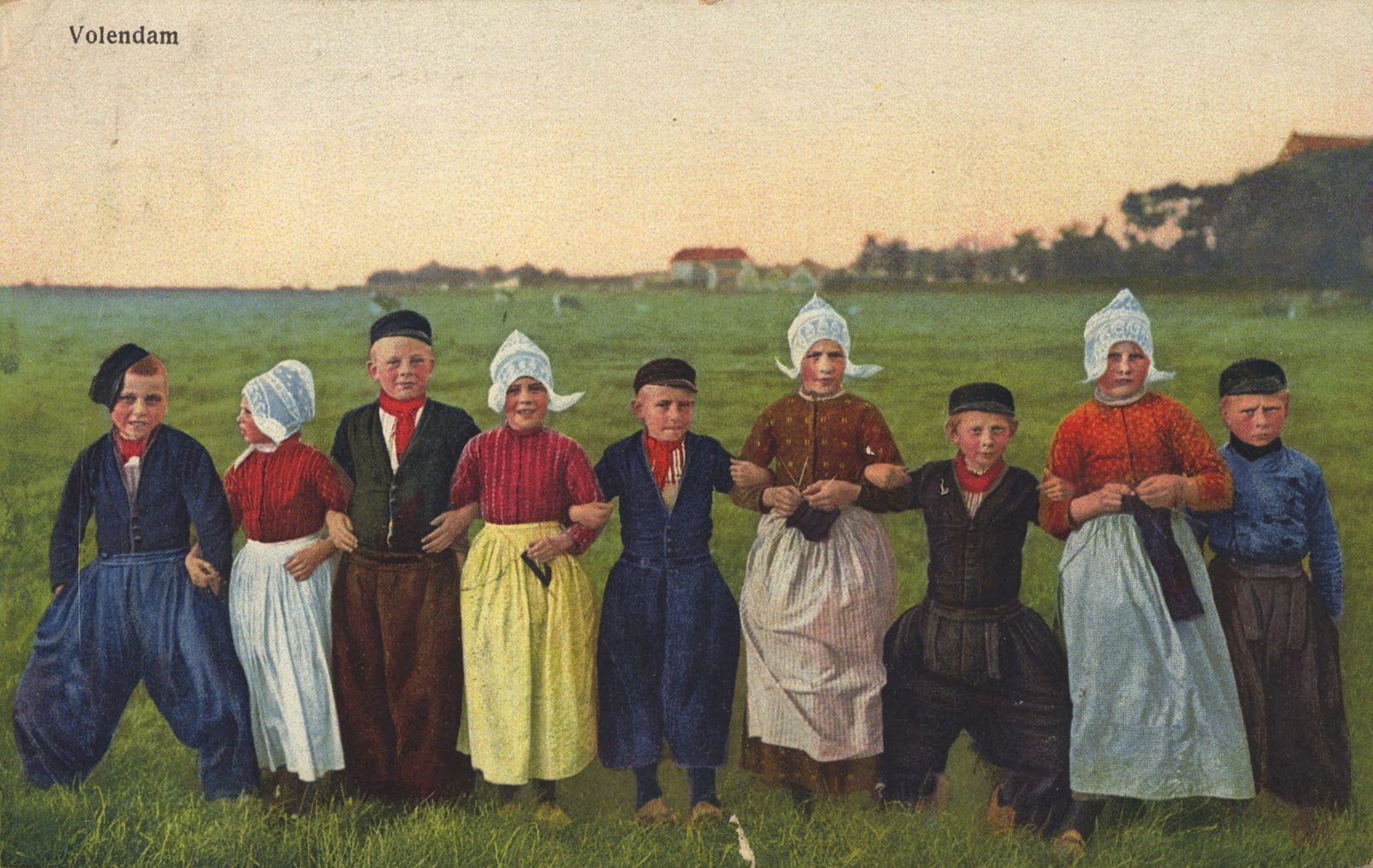Dutch traditional wear, rich in history and cultural significance, reflects the diverse regional identities and historical influences of the Netherlands. This article explores ten iconic outfits from Dutch tradition, offering insights into their unique features, historical contexts, and modern relevance. Each outfit represents a different part of Dutch heritage and serves as a window into the country’s vibrant cultural tapestry.
Dutch Traditional Wear: Volendam Costume
The Volendam costume is perhaps one of the most recognizable Dutch traditional outfits. Originating from the fishing village of Volendam, this attire features a distinctive combination of bright colors and intricate embroidery. The women’s costume includes a high lace cap called a “kraplap,” a bodice with elaborate stitching, and a voluminous skirt. Men’s outfits typically consist of a striped shirt, high-waisted trousers, and a distinctive black hat.
Historical Context: The Volendam costume dates back to the 17th century and reflects the maritime heritage of the region. The outfit’s elaborate design was initially worn by the local fishing community and has become a symbol of Dutch cultural pride.
Dutch Traditional Wear: Friesian Costume
The Friesian costume represents the northern province of Friesland. It is known for its elegant and practical design, which includes a high-necked blouse, a colorful apron, and a distinctive headpiece called a “dokkep,” often adorned with silver ornaments.
Historical Context: The Friesian costume is deeply rooted in the agricultural traditions of Friesland. Its practical elements were designed for daily work on the farm, while the silver adornments signify wealth and status within the community.
Groningen Costume
From the northern province of Groningen, this traditional outfit features a vibrant and eye-catching design. Women’s attire includes a fitted bodice, a long skirt with a colorful apron, and a distinctive cap. Men’s outfits often include a striped vest and breeches.
Historical Context: The Groningen costume reflects the region’s agricultural heritage and its historical connections with both trade and local craftsmanship. The vibrant colors and patterns are symbolic of the region’s rich cultural life.
Zaanse Schans Costume
The Zaanse Schans costume is a traditional outfit from the Zaan region, known for its historical windmills and wooden houses. The women’s costume includes a striped dress, a high lace cap, and a colorful apron. Men’s attire often features a buttoned vest and wooden shoes.
Historical Context: This costume is a reflection of the Zaan region’s historical economy, which was centered around windmills and agriculture. The outfit’s practicality and durability speak to the hardworking nature of the local people.
Haarlem Costume
The Haarlem costume, hailing from the city of Haarlem, is known for its sophisticated and elegant design. Women’s costumes feature a richly embroidered dress, a lace cap, and a decorative collar. Men’s attire includes a fitted coat, trousers, and a stylish hat.
Historical Context: The Haarlem costume is associated with the city’s status as a major trade and cultural center in the Netherlands. Its refined design reflects the city’s affluence and cultural sophistication during the Golden Age.
Utrecht Costume
The Utrecht costume is characterized by its classic and understated elegance. Women’s attire includes a simple yet graceful dress with a high collar, a matching apron, and a modest headpiece. Men’s outfits typically feature a dark vest, breeches, and a formal hat.
Historical Context: The Utrecht costume is a testament to the city’s historical role as a religious and political center. The design emphasizes modesty and formality, reflecting the city’s influential position in Dutch history.
Limburg Costume
The Limburg costume is known for its intricate lacework and decorative elements. Women’s attire includes a colorful dress, a high lace collar, and a distinctive bonnet. Men’s outfits often feature a patterned vest and trousers, complemented by a hat.
Historical Context: Originating from the southern province of Limburg, this costume highlights the region’s connections with both Dutch and Belgian cultures. The elaborate lacework represents the region’s craftsmanship and artistic heritage.
Zeeland Costume
The Zeeland costume is distinguished by its nautical elements, reflecting the province’s maritime history. Women’s attire features a practical dress with a nautical theme, complemented by a sailor’s hat. Men’s outfits include a striped shirt, trousers, and a matching cap.
Historical Context: Zeeland’s history as a maritime hub is evident in the costume’s design. The outfit’s practical elements and nautical themes reflect the province’s close connection to the sea and its seafaring traditions.
Bovenkarspel Costume
The Bovenkarspel costume is characterized by its rich fabrics and vibrant colors. Women’s attire includes a detailed dress with intricate embroidery, a colorful apron, and a distinctive headpiece. Men’s outfits often feature a fitted vest and matching trousers.
Historical Context: This costume originates from the village of Bovenkarspel and reflects the local agricultural and artisanal traditions. The use of rich fabrics and colors signifies the community’s pride and cultural identity.
Schoonhoven Costume
The Schoonhoven costume is known for its elegant and refined design. Women’s attire includes a long dress with a high lace collar, a decorative apron, and a delicate bonnet. Men’s outfits typically feature a formal vest, trousers, and a stylish hat.
Historical Context: Schoonhoven’s costume reflects the city’s historical reputation for craftsmanship and trade. The elegant design of the outfit highlights the city’s cultural and economic significance during the medieval period.
Conclusion
Dutch traditional wear offers a fascinating glimpse into the country’s diverse regional cultures and historical influences. Each iconic outfit tells a story of its origin, reflecting the unique traditions and lifestyles of different regions. From the vibrant Volendam costume to the elegant Schoonhoven attire, these traditional garments not only celebrate Dutch heritage but also serve as enduring symbols of cultural pride.
As we continue to appreciate and explore these traditional outfits, we gain a deeper understanding of the Netherlands’ rich cultural tapestry and the importance of preserving these historical garments for future generations.
FAQs
1. What are some key features of Dutch traditional wear?
Dutch traditional wear often includes distinctive headpieces, colorful aprons, and intricate embroidery. Each regional costume reflects the local history, economy, and cultural practices.
2. Why are traditional Dutch outfits still worn today?
Traditional Dutch outfits are worn during festivals, cultural events, and special occasions to celebrate and preserve the Netherlands’ rich heritage and regional identities.
3. How do Dutch traditional costumes vary by region?
Each region in the Netherlands has its own unique traditional costume, reflecting local history, occupation, and cultural influences. For example, the Volendam costume is vibrant and maritime-themed, while the Friesland costume features practical elements suited for agricultural life.
4. Are there modern adaptations of Dutch traditional wear?
Yes, modern adaptations of Dutch traditional wear often incorporate contemporary fabrics and designs while maintaining traditional elements. These adaptations are popular for ceremonial occasions and cultural festivals.
5. Where can I see Dutch traditional costumes in person?
Dutch traditional costumes can be seen at cultural festivals, historical museums, and during regional events throughout the Netherlands. Popular destinations include open-air museums like Zaanse Schans and traditional festivals in various provinces.
Also read: Texel Island: Top 10 Outdoor Adventures to Explore




